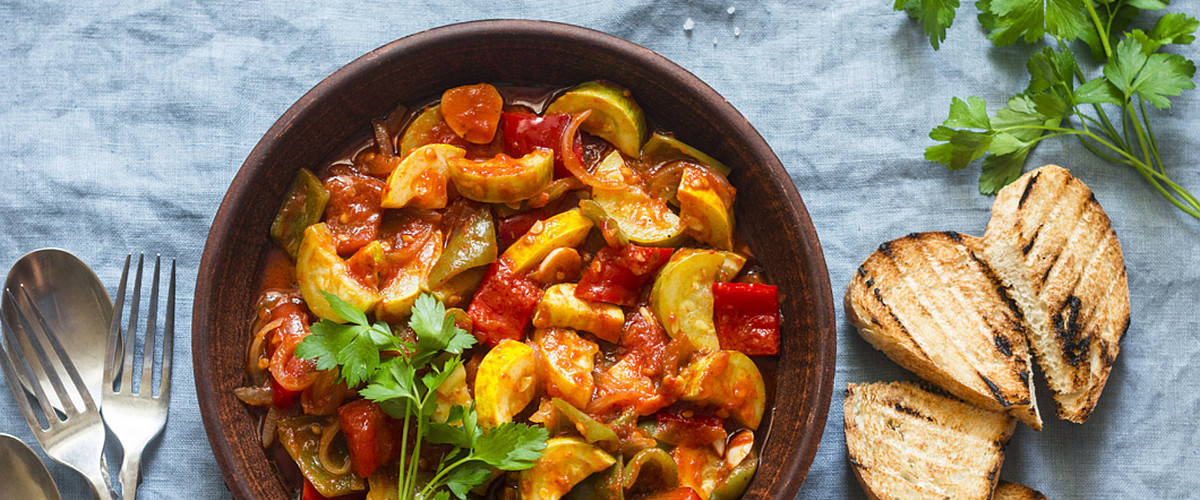Nothing hits the spot quite like comfort food. Comfort foods evoke fond memories like holidays and home. If a dish is satisfying, tasty, and brimming with nostalgia, it’s probably comfort food (and we’re probably hungry for it!)

Chef Tim Zintz
Traditional comfort foods share something else in common, too: They’re usually loaded with creamy, rich ingredients that just aren’t that good for us. That means they could use a little help in the nutrition department. But with a few tips and tricks, comfort foods can still have their place in a healthier lifestyle.
For this, we turned to Chef Tim Zintz, Director of Culinary, who has decades of experience developing healthier meals at Aramark.
He’s here to help you lighten up your go-to comfort food recipes—without losing all that you love about them.
A Swap for Every Favorite
While comfort food favorites vary from person to person, some dishes top almost everyone’s list. Here, Chef Tim gets to the heart of nine classic meals to share healthy cooking swaps you can use at home. Get your casserole dish ready!
Classic #1: Chicken Pot Pie
Why we love it: Creamy filling nestled inside a flaky crust really is the best of both worlds.

Get Recipe: Chicken Pot Pie
Where it could use some help: Butter in the crust, plus cream or whole milk in the filling, contribute lots of saturated fat, which has been associated with a variety of negative health consequences when overconsumed in our diets. The crust is usually made with all-purpose flour, as well, which isn’t as nutritious as whole wheat flour.
The Swap: Chef Tim says, deconstruct it! Make your next chicken pot pie with only a top crust. Or, for a fun spin, serve the bread component on the top as a small biscuit, piece of cornbread, or a pie dough “hat.”
Why it works: “By breaking chicken pot pie into its parts, you can achieve the same flavors and textures but in better-for-you proportions,” says Chef Tim. “You really won’t miss the bottom crust.”
Take it to the next level: To make chicken pot pie even better for you, swap the cream or whole milk for equal amounts of skim or reduced-fat milk (or chicken broth or stock).
Recipe to try: Chicken Pot Pie
Classic #2: Macaroni and Cheese
Why we love it: Mac ‘n cheese is a major crowd-pleaser, especially with kids. Few people can turn down this cheesy, starchy one-bowl meal.
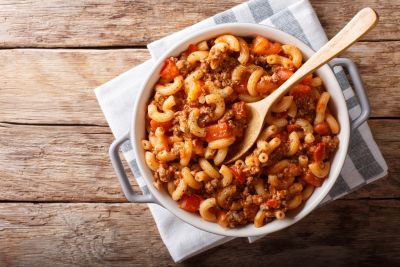
Get Recipe: Hearty Macaroni Bake
Where it could use some help: Saturated fats show up again in the form of cheese and butter (you’ll notice these ingredients have a recurring role in many comfort foods). Plus, white pasta isn’t as nutritious as whole wheat.
The Swap: Rethink your dairy options when making the sauce. Try a “better butter” substitute such as plant-based margarine and use 2% milk instead of cream or whole milk.
Why it works: “This swap lets you keep what people love most about mac ‘n cheese, which is the al dente pasta and the cheesy flavor,” Chef Tim explains.
Take it to the next level: Once you get the hang of a lighter mac ‘n cheese, try adding cooked vegetables to the mix for more fiber and vitamins. Butternut squash and cauliflower tend to blend well with the texture of mac ‘n cheese, Chef Tim advises. Broccoli also complements the cheesy flavor profile nicely. Or try fiber-rich whole-wheat instead of regular pasta—some people enjoy the nuttier bite.
Recipe to try: Take your macaroni in another direction with our Hearty Macaroni Bake.
Classic #3: Meatloaf
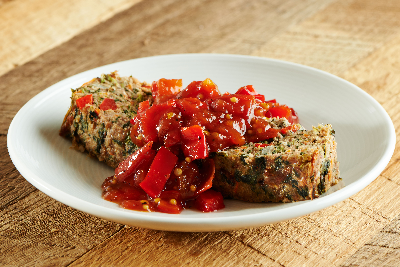
Get Recipe: Turkey Meatloaf with Tomato-Ginger Chutney
Why we love it: Meatloaf is the very definition of comfort food, reminding so many people of their mother’s or grandmother’s cooking.
Where it could use some help: Here, ground beef is the offender (and sometimes pork or veal). Red meat is another source of saturated fat.
The Swap: Use ground turkey, diced mushrooms, or a combo of the two! Chef Tim recommends substituting one-quarter of the meat ingredients and working your way up. “Turkey is a leaner protein than beef but still very flavorful,” he shares. “And like most veggies, mushrooms are low-calorie and fat-free. But when you cook them, they explode with umami flavor.”
Why it works: With this swap, you get meatloaf’s trademark flavor and texture but with better-for-you ingredients. (And yes, you can still top it with ketchup.)
Take it to the next level: This swap works for meatballs, too. Try it on your next pasta night!
Recipe to try: Turkey Meatloaf with Tomato Ginger Chutney
Classic #4: Mashed Potatoes
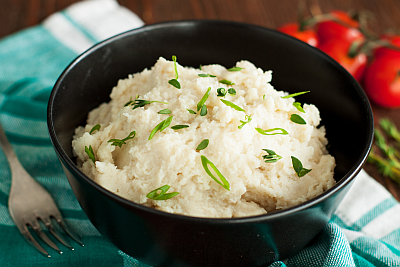
Get Recipe: Cauliflower Potato Mash
Why we love it: Whether you’re planning Sunday night dinner or a Thanksgiving feast, this stick-to-your-ribs side pairs well with so many dishes.
Where it could use some help: Traditional mashed potato recipes are loaded with butter and cream to give it a rich, smooth consistency.
The Swap: Try broth or stock in place of cream, milk, or butter. You can use chicken or vegetable varieties based on your preference. Store-bought works well here—but if you’ve got the time and the interest in making something even better, you can make your own!
Why it works: Says Chef Tim: “Broth is a much lighter way to attain that smooth texture you crave in your mashed potatoes, with really interesting, complex flavor.”
Take it to the next level: Veggies can bulk up many starchy sides. Swap in riced cauliflower, parsnips, or butternut squash for some of the potatoes for extra fiber and better nutrition.
Recipe to try: Cauliflower Potato Mash
Classic #5: Cream-Based Soup
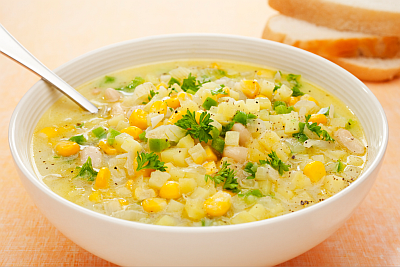
Get Recipe: Roasted Corn Chowder
Why we love it: Common cream-based soups include broccoli and cheese, chowders, and bisques. A steamy bowl can surely warm and fill you up on a chilly winter evening.
Where it could use some help: It’s right there in the name! “Broth-based soup is generally a healthier meal choice, but adding cream tips the scales in the wrong direction when it comes to health,” Chef Tim points out.
The Swap: Many cream-based soups start with a roux of flour and butter to create thickness. But any fat will do for a roux, so why not make it a healthier one? Start with a roux of equal parts flour and heart-healthy olive oil instead, then combine it with broth. “If you want, you can add a splash of 2% milk toward the end of cooking for a creamier color,” he says.
Why it works: Again, the key to a successful swap is to mimic the role of the original ingredients. In this case, you’re replicating the color and deliciously thick texture of a cream-based soup with heart-healthier swaps.
Take it to the next level: Do you like your soups to stick to the spoon? Pureed white beans can yield the same effect while lending plant-based protein and fiber. Simmering your soup longer at a lower temperature results in a thicker, richer, more flavorful soup. “Low and Slow” is Chef Tim’s mantra!
And for cream soups like broccoli or mushroom, use the tops for the soup, but make stock out of the stems—better flavor, no waste!
Recipe to try: Roasted Corn Chowder
Classic #6: Chili
Why we love it: Nothing goes better with Game Day than a big ol’ pot of chili.
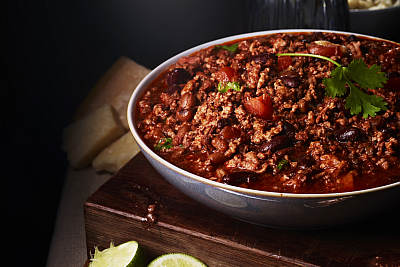
Get Recipe: Joaquin’s Texas Chili
Where it could use some help: Between the red meat and standard toppings like cheese and sour cream, saturated fat can stack up quickly.
The Swap: Thankfully, you have many options to improve chili’s nutrition score, Chef Tim assures us. The first is to use ground turkey in place of beef, like in the meatloaf swap above. The second is to replace some or all the meat with beans. The third is to bulk up your chili with veggies like diced bell peppers and celery.
Why it works: “Much of the chili flavor comes from the spices themselves,” Chef Tim explains. “This means you can play with other ingredients with minimal impact on taste.” These swaps can help you stretch the recipe and your food budget, too.
Take it to the next level: While your chili is simmering on the stove or in the slow cooker, take time to rethink your toppings. Go easy on the shredded cheese and try sliced avocado or a sprinkle of fresh green onion. Greek yogurt also makes for a creamy, tangy topping with much less fat and more protein than sour cream.
Recipe to try: Joaquin’s Texas Chili
Classic #7: Grilled Cheese
Why we love it: This gooey, melty sandwich reminds us of childhood, especially when dipped in tomato soup.
Where it could use some help: There’s the saturated fat in the cheese, of course. But don’t overlook the butter used for grilling. Also, white bread isn’t as nutritious as other options.
The Swap: Chef Tim’s advice is to let the cheese stand alone. “You don’t want to mess with the cheese because it’s really hard to replicate,” he says. “Use the cheese you love—the more flavorful it is, the more satisfying it will be.” Then, for a nutritious boost, he recommends choosing a hearty whole-grain bread that comes in 1-ounce slices (many varieties are 2 ounces or more).
Why it works: You can’t make a sandwich without bread, so you might as well pick one with more fiber and other nutrients. You might be surprised at how much more filling that swap can be! Chef Tim also says that two slices of cheese is plenty, “any more and you won’t get a good melt or risk burning the bread.” He also recommends using shredded cheese to provide better coverage with a little less cheese.
Take it to the next level: Pair your sandwich with a lower-sodium soup, which is a health plus. Plus, you can use a butter substitute, cooking spray, or nonstick pan to achieve a crispy outer texture when browning your grilled cheese.
Recipe to try: Pumpkin, Sweet Potato & Apple Bisque for something more complex than your usual tomato soup.
Classic #8: Pancakes
Why we love it: Rise and shine! The smell of pancakes will get anyone out of bed in the morning.
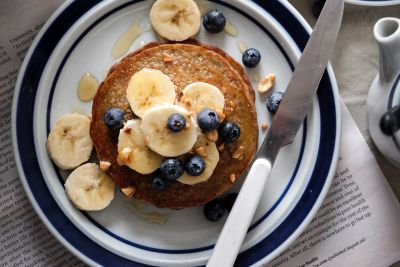
Get Recipe: Whole-Wheat Banana Pancakes
Where it could use some help: Basic pancakes are primarily refined carbohydrates, which can do a number on your blood sugar—so you might experience that energy crash or get hungry again before lunch.
The Swap: For some filling fiber, use whole-wheat flour or oats in the pancake batter. You don’t have to go all in; start with a 50% swap and see how you like it.
Why it works: Subtle changes go a long way to make this weekend breakfast staple more nutritious.
Take it to the next level: What you put on top of a dish is just as important as what goes into it. So tackle your toppings: Try “better butter” instead of butter or homemade fruit compote instead of maple syrup. To make your compote, Chef Tim says to mix 1 cup of fresh berries with 1 tbsp. sugar and let sit overnight. Easy!
Recipe: Whole Wheat Banana Pancakes
Classic #9: Fruit Pie
Why we love it: Apple or cherry, peach or blueberry … this dessert is the perfect way to end a meal at any time of year.

Get Recipe: Mixed Berry Cobbler
Where it could use some help: Sadly, added sugar in the filling cancels out the good-for-you fruit. Butter also weighs down the flaky crust.
The Swap: We’d like you to meet pie’s fruit-forward cousins, the fruit crisp and the fruit crumble. But whatever you do, Chef Tim warns, don’t use canned filling! “Make your own filling from seasonal fresh fruit. Frozen fruit also works great (thaw it first). You can control the sweetness level, and your baked goods will taste better,” he says.
Why it works: A fruit crisp or crumble offers the same sweet-tart flavor and pleasing texture but with a smaller topping-to-filling ratio than pie. They also happen to be much easier and faster to make! Incorporate a whole grain like rolled oats into the topping for an extra plus.
Take it to the next level: Does your fruit dessert feel incomplete without ice cream? Opt for a small scoop of frozen yogurt or whipped topping instead. You’ll get that creamy warm-cool sensation with fewer calories and less fat.
Recipe to try: Mixed Berry Cobbler
Swap It to Me
Lightening up your treasured comfort food recipes can be a matter of substitution, addition, or subtraction. No matter which direction you choose, try one tip at a time and see what works. You can experiment at dinnertime before you serve your new-and-improved recipe on a special occasion.
“Most of these dishes have so many ingredients and layers of flavor, you and your family won’t notice much of a difference,” says Chef Tim. “Even if it’s not a runaway hit, it will probably still be delicious.”
One final note: Resist the urge to go all or nothing. A healthy lifestyle is all about balance, not perfection. As Chef Tim puts it: “Don’t let healthy get in the way of healthier or a dish’s authenticity. Comfort food brings people immense joy—so enjoy it, and start making some new memories.”
Chef Tim’s Go-To Tricks for Making Meals a Little Healthier
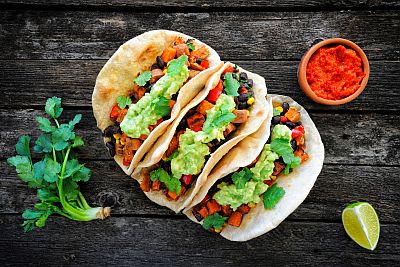
Get Recipe: Spicy Sweet Potato and Black Bean Tacos
Got a favorite recipe we haven’t mentioned yet? Never fear. These tried-and-true tips can work for just about any meal.
- Eat your greens. Make a habit of serving every meal with steamed veggies or a side salad, aiming to fill half your plate.
- Treat veggies like meat. Replace some or all the meat ingredients with veggies or beans. You’ll lower the saturated fat content significantly while gaining fiber, vitamins, and antioxidants.
- Deconstruct it. Consider the purpose of each ingredient and decide what is most important to you in terms of texture, form, and flavor. This will help you choose which meal ingredients to swap—again, try only one or two at a time.
- Right-size your portions. Don’t change a thing! Enjoy what you love and savor it mindfully in smaller portions.
Note: Since everyone’s health history and nutritional needs are so different, please make sure that you talk with your doctor and a registered dietitian to get advice about the diet and exercise plan that‘s right for you.

